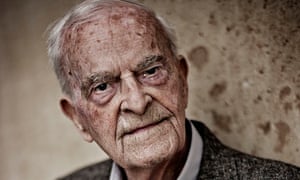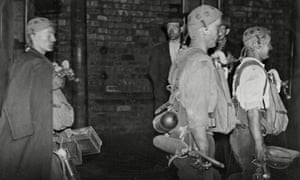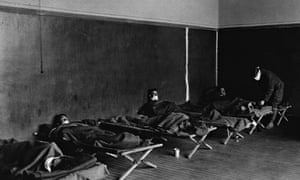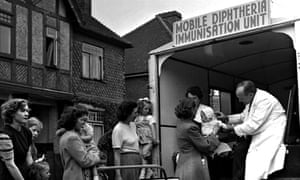'
A eulogy to the NHS: What happened to the world my generation built?
In 1926, Harry Leslie Smith's sister died of TB in a workhouse infirmary, too poor for proper medical care. In 1948, the creation of the NHS put a stop to all that. In an extract from his new book, Harry's Last Stand, he describes his despair at the coalition's dismantling of the welfare state
Amidwife with a penchant for gin delivered me into the arms of my exhausted mother on a cold, blustery day in February 1923. I slept that night in my new crib, a dresser drawer beside her bed, unaware of the troubles that surrounded me. Because my dad was a coal miner, we lived rough and ready in the hardscrabble Yorkshire town of Barnsley. Money and happiness didn't come easily for the likes of us.
Considering the hunger, the turmoil and the squalor in Britain during the early years of the 20th century, it was miraculous that I lived to see my third birthday. That I survived colic, flu, infection, scrapes and bangs without the benefits of modern sanitation, hygiene or health care, I must give thanks to my sturdy peasant genes. As a baby, I was ignorant of the great sorrow that enveloped England and Europe like a damp, grey fog. The nation was still in mourning for her dead from the world's first Great War. It had ended only five short years before my arrival. Nearly a million British soldiers had been killed in that conflict. It had begun in farce in 1914 and ended in bloody tragedy in 1918. In four years, that war killed more than 37 million men, women and children around the world.
Even when the guns across the battlefields were made dumb by peace, the killing didn't stop. Death refused to take a holiday and a pestilence stormed across the globe. It was called the Spanish flu. The pandemic lasted until 1921 and erased 100 million people from the ledger book of the living.
Like most people in Barnsley, my family occupied a terraced house. They were built back-to-back and in a row of 10 units. There was little space, privacy or comfort for us or any of the other occupants. It was just a place to rest your head after spending 10 hours hacking coal from the side of a rock face hundreds of feet below ground. Three walls out of four were connected to another household.
The floors were made of hard slate rock and were sparsely covered with old rags that had been hand-woven into coarse mats. The interior walls were comprised of wet limestone coated in a gruel-thin whitewash that never seemed to look clean.
In summer our home was hot, in autumn damp, and in winter bitterly cold, while spring was as wet as autumn again. The house had no electricity and only the parlour and scullery possessed a gaslight fixture. After sunset, it sputtered and hissed a gloomy yellow light that illuminated our poverty. I shared a room with my older sister, Alberta. We slept together on a straw mattress that was host to many insects and reeked of time and other people's piss. Its covering was made from a rough material that was as uncomfortable to me as the occasions when my father tickled my face with his moustache. Depending on the season, I slept in my undershirt or remained fully clothed. During the cold months, Alberta and I nestled together and shared our body heat to stave off the chilling frost beating against the windowpane. Our parlour had no furniture except a stool and an upright piano that had come as part of my dad's legacy from his father. But it stood mute against the wall because the room was occupied by my infirm and dying eldest sister, Marion.
At the age of four she had contracted tuberculosis, which was a common disease among our class. Her ailment was caused because my parents were compelled to live in a disease-ridden mining slum at the end of the Great War. Eventually my parents were able to leave the slum but by then the damage had already been done to my sister's health, and the TB spread into her spine. It left her a paraplegic with a hunchback. For the last 12 months of her life, Marion was totally dependent on my mother to be fed, bathed and clothed. In those days, there was no national health service; you either had the dosh to pay for your medicine or you did without. Your only hope for some medical care was the council poorhouse that accepted indigent patients.
As a young lad, I was encouraged by my parents to spend time with my ailing sister. I think it was because they knew that she was dying and they wanted me to remember her for the rest of my life. I didn't comprehend illness or death because I was only three, so I contented myself with playing near her sick bed. On some occasions, I told her nonsense stories, but my sister couldn't respond to my kindness because the disease had destroyed her vocal cords.
Even though she was in extreme pain while the TB ate away at her spine and invaded her vital organs, she was silent. My sister always seemed to be looking past me with her large expressive eyes. Perhaps she was waiting for death, or perhaps she found the gaslight casting shadows on the opposite wall an appealing distraction from the monotony of the pain that consumed her 10-year-old body.
TB was known in the 19th century as the poet's disease, but I saw no lyricism in the way it killed Marion. As the autumn days grew shorter in 1926, so did the time my sister had to live. Her last weeks were unbearable but she still fought death. She thrashed her arms about in defiance against the coming end to her life. My parents tried to calm her by stroking her hair or singing to her, but she wasn't pacified. Instead, Marion wept silent tears and continued to struggle with so much ferocity that in the end my dad reluctantly restrained her to her bed with a rope.
My parents decided that there was nothing more that could be done for Marion in their care, so they arranged for her to be placed in our local workhouse infirmary. It was the last stop for many people who were too poor to pay for a doctor or proper hospital care. The workhouse in our community was a forbidding building that had been constructed during the age of Dickens. In the century before I was born it was used to imprison debtors, house orphans and provide primitive health care to the indigent. By the time Marion was sent there, it was no longer used as a prison. However, orphans, the sick and those with communicable diseases were still incarcerated behind its thick, towering black walls.
On one of the last days in September my mother pawned her best dress and my father's Sunday suit and hired a man with an old dray horse and cart to come to our house and collect Marion. When he arrived, my dad carried Marion outside and carefully placed her into the delivery carriage where my mother was waiting
Alberta and I stood on the side of the street and waved goodbye to Marion. I asked my dad where my sister was going and he mournfully replied: "She's going to a better place than here." Afterwards, he put his arms around me and Alberta and we watched the horse-drawn carriage slowly plod down our road towards the workhouse infirmary.
That was the last time I saw my sister alive.
Marion died a month later in the arms of my mother. There was no wake, no funeral service and even much later there was no headstone erected to mark her brief passage in life. My family, like the rest of our community, was just too poor to afford the accoutrements of mourning. We relied on my dad's minuscule salary just to keep us with a roof over our heads and dry in the perpetual hard luck rain of Yorkshire. Even my dead sister's landau was quickly dispatched to the pawnbroker's shop where it was swapped for a few coins to help feed her hungry living siblings.
My sister's body was committed to a pauper's pit and interred in an unmarked grave along with a dozen other forgotten victims of penury. My parents didn't even have a picture to remember their daughter's life. To the outside world, it was as if she was never there, but for our family her life and her end profoundly affected us. My father never mentioned Marion's name again. It wasn't out of callousness or disrespect, but because her death festered in his soul like a wound that never healed. For the rest of his life my dad carried with him an unwarranted guilt that he was responsible for Marion's tuberculosis, and it cut him deep. As for my mother, she often talked about Marion. As my family stumbled from misery to calamity, through the pitch dark of the Great Depression, my mother invoked my dead sister's name as a warning that the workhouse awaited each of us, unless the world and our circumstances changed.
It would be almost 20 years before, in 1948, the NHS was formed, and for the first time in my civilian life I went to a doctor's surgery and was treated for bronchitis with antibiotics that assured me a speedy and safe recovery. The cost to me was nothing, and I was grateful because I was skint, having just started back in the civilian working world.
As I convalesced, I was gobsmacked at the great consequences of free health care and the potential it offered to improve our society. It was a transformational shift in how we as a country viewed our fellow citizens. The creation of the NHS made us understand that we were in truth our brother's keeper, and that taxation benefits everyone through maintaining not just our roads and sewers but the health of our children, workers and elderly.
To me, the introduction of free health care was the first brick laid on the road to the social welfare state. So it has always been difficult for me to listen to politicians, proud possessors of health insurance and shares in private health care companies, when they talk about how the health service that we fought so hard to build must change. The coalition government's Health and Social Care Act will create a two-tier health care system. This act will see the NHS stripped down like a derelict house is by criminals for copper wiring.
Ukip has even proposed that A&E patients should have the right to buy their way to the front of the queue, while in Merseyside a private for-profit cancer clinic has set up shop under the NHS umbrella. Where will all of this end? What will be given the greatest priority in a new health care system that sends every service, from blood work to chemotherapy, out to the lowest bid tender?
It ends where I began my life – in a Britain that believed health care depended on your social status. So if you were rich and insured you received timely medical treatment, while the rest of the country got the drippings. One-fifth of the lords who voted in the controversial act – which provides a gateway to privatise our health care system – were found to have connections to private health care companies. If that doesn't make you angry, nothing will.
Sometimes I try to think how I might explain to Marion how we built these beautiful structures in our society – which protected the poor, which kept them safe at work, healthy in their lives, supported them when they were down on their luck – only to watch them be destroyed within a few short generations. But I cannot find the words.
Harry's Last Stand by Harry Leslie Smith is published by Icon Books at £12.99. To order a copy for £9.99, visit theguardian.com/bookshop or call 0330 333 6846.'





